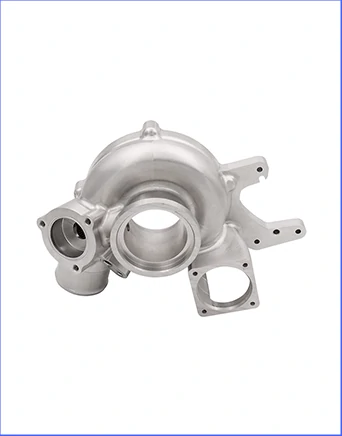Time to read: 6 min

Precision machining stands as a cornerstone of modern manufacturing, underpinning the production of intricate components with high accuracy. This article explores the intricate process of precision machining, its advantages, and its applications across various industries, with a focus on the automotive sector.
Introduction
Precision machining has evolved in tandem with technological progress, becoming indispensable in the creation of complex, high-precision parts necessary for today's advanced machinery.
Key Concepts in Precision Machining
Precision Machines
Precision machines are high-accuracy fabrication tools guided by computer numerical control (CNC) technology, capable of executing a variety of operations with exceptional precision.
Precision Manufacturing
This term refers to the industry practices that prioritize the production of components with minimal variance from exact specifications through the use of advanced machinery and stringent quality controls.
CNC Manufacturing
CNC manufacturing is distinguished by its use of programmed machines for high-precision and efficient operations, streamlining the manufacturing process.
Computer-Aided Design (CAD)
CAD is pivotal in creating detailed digital models of physical components, facilitating design construction, modification, and optimization before physical production.
The Precision Machining Process
Step 1: Design Using CAD
The process initiates with a part's conceptual sketch, followed by the creation of a detailed digital model using CAD software.
Step 2: Conversion to CAM
The digital model is then translated into machine-readable code, essential for guiding the CNC machine's operations.
Step 3: Material Selection and Preparation
Material choice is dictated by the part's functional requirements, machinability, and cost, with steel and aluminum being common selections.
Step 4: Setup of Precision Machinery
This involves the calibration of tools, checking of fluid levels, and a potential dry run to ensure accuracy.
Step 5: Execution of Machining
With the setup complete, the machining process commences, with initial stages closely monitored for any necessary adjustments.
Step 6: Post-Processing Steps
Final parts may undergo additional finishing processes and rigorous quality checks to ensure adherence to precise dimensions.
Types of Precision Machining Machinery
CNC Milling Machines
These machines use rotary cutters for material removal and are ideal for creating complex geometries in various materials.
CNC Turning Centers (Lathes)
CNC lathes are designed for creating symmetrical parts and can incorporate live tooling for multi-process machining.
Swiss-Type Lathes
Swiss-type lathes are known for their precision and ability to produce extremely small and intricate parts.
Multi-Axis Machining Centers
These centers offer the capability to perform multiple operations without repositioning the workpiece, facilitating complex part production.
Mill Turning CNC Centers
Combining milling and turning capabilities, these centers are space-efficient and enhance product consistency.
CNC Grinding Machines
Used for achieving high-accuracy surface finishes and dimensional tolerances, these machines are ideal for finishing operations.
CNC Drill Presses
CNC drill presses are designed for high-precision hole placement and size, reducing manual errors.
Electrical Discharge Machines (EDM)
EDM machines are suitable for machining hard or fragile materials with intricate designs.
Laser Cutting and Engraving Machines
These machines use high-power lasers for cutting, engraving, or marking materials, suitable for both metals and non-metals.
Water Jet Cutters
Employing a high-pressure stream of water and abrasive particles, water jet cutters offer a non-thermal cutting method.
Selecting Materials for Precision Machining
A variety of materials, including metals, plastics, composites, ceramics, and advanced materials, can be machined with precision, depending on their characteristics and end-use applications.
Applications of Precision Machining
Precision machining is utilized across industries such as aerospace, medical, automotive, electronics, tool and die making, energy, and defense.
Advantages of Precision Machining Techniques
High Accuracy and Tight Tolerances
Precision machining ensures minimal deviation from design specifications, critical for the functionality and safety of components.
Complexity and Flexibility
CNC machines allow for the creation of complex parts and quick design adjustments, facilitating efficient prototyping and customization.
Efficiency and Speed
The automation inherent in CNC machining significantly reduces production time, enhancing overall efficiency.
Improved Quality and Reliability
Precision machining results in uniform, high-quality parts, reducing the likelihood of errors and waste.
Cost-Effectiveness
Despite initial setup costs, precision machining proves to be a cost-effective solution for both mass production and custom parts.
Accuracy vs. Precision in Machining
While accuracy pertains to how close a part's measurements are to design specifications, precision relates to the consistency of these measurements across multiple parts.
Potential Drawbacks of Precision Machining
High Initial Investment
The upfront cost of CNC machinery can be substantial, particularly for industrial-grade equipment.
Complex Setup and Operation
CNC machines require skilled operators and a sophisticated setup, adding to labor costs.
Economic Scalability
The high setup costs may make precision machining less viable for very large production runs.
Outsourcing Precision Machined Products
For businesses considering precision machining, outsourcing to a certified company like Unofactory can ensure quality and efficiency without the need for in-house machinery.
Conclusion
Precision machining is indispensable for the manufacturing of high-precision components, playing a vital role in various industries. As technology advances, the demand for precision machining is set to increase, further cementing its place in the manufacturing landscape.




